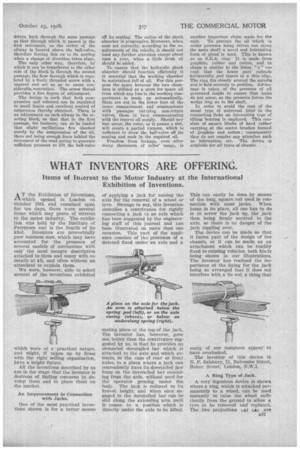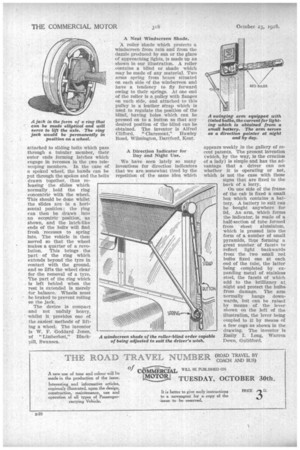WHAT INVENTORS ARE OFFERING.
Page 31

Page 32

If you've noticed an error in this article please click here to report it so we can fix it.
Items of Interest to the Motor Industry at the International Exhibition of Inventions.
AT the Exhibition of Inventions, which opened in London on October 10th and remained open for ten days, there were several items which may prove of interest to the motor industry. The exhibition was held by the Institute of Patentees and is the fourth of its kind. Inventors are proverbially poor business men, which may have accounted for the presence of several models of mechanism with only the most meagre description attached to them and many with no details at all, and often without an
attendant to explain them.
We were, however, able to select several of the inventions exhibited
which were of a -practical nature, and might, if taken up by firms Nvith the right selling organization, have a bright future.
All the inventions described by us are in the stage that the inventor is desirous of finding concerns to develop them and to place them on the market.
An Improvement in Connection with Jacks.
One of the most practical inventions shown is for a better means of applying a jack for raising the axle for the removal of a wheel or tyre. Strange to say, this invention embodies a contrivance for rigidly connecting a jack to an axle which has been suggested by the engineering stag of this journal and nas been illustrated on more than one occasion. This part of the appliance consists of the provision of a dovetail fixed under an axle and a mating piece at the top of the jack. The inventor has, however, gone one better than the contrivance suggested by us, in that he provides an elongated dovetailed bar which is attached to the axle and which extends, in the case of rear or front axles, to a place where a jack can conveniently have its dovetailed jaw hung on the dovetailed bar extending from the axle, without need for the operator groping under the body. The jack. is reduced to its lowest height, and when once engaged in the dovetailed bar can be slid along the extending arm until it comes to a position which is directly under the axle to be lifted.
This can easily be done by means of the long, square rod used in connection with most jacks. When home in its place, all one has to do is to screw the jack up, the jack then being firmly secured to the axle, so there is no danger of the jack toppling over.
The device can be made so that it forms part of the design of the chassis, or it can be made as an attachment which can be readily fixed to existing vehicles, both kinds being shown in our illustrations. The inventor has realized the importance of the fixing for the jack being so arranged that it does not interfere with a tie rod, a thing that many of our designers appear to have overlooked.
The inventor of this device is N. P. Salsbury, 11, Baleombe Street, Baker Street, London, N.W.1.
A Ring Type of Jack.
A very ingenious device is shown where a ring, which is attached' permanently to a wheel, can be used instantly to raise the wheel sufficiently from the ground to allow a tyre to be removed and replaced. The two projections k,.4.). .61., are
attached to sliding bolts which pass through a tubular member, their outer ends forming latches which engage in recesses in the two telescoping members. In the case of a spoked wheel, the hands can be put through the spokes and the bolts drawn together, thus releasing the slides which normally, hold the ring concentric with the wheel. This should be done whilst the slides are in a horizontal position ; the ring can then be drawn into an eccentric position, as shown, and the latch-like ends of the bolts will find fresh recesses to spring Into. The vehicle is then moved so that the wheel makes a quarter of a revolution. This brings the part of the ring which extends beyond the tyre in contact with the ground, and so lifts the wheel clear for the removal of a tyre. The part of the ring which is left behind when the rest is extended is merely for balance. Wheels must be braked to prevent rolling on the jack.
The device is compact and not unduly heavy, whilst it provides one of the easiest methods of lifting a wheel. The inventor is W. F. Goddard Jones, of "Limberlost," Blackpill, Swansea. A Neat Windscreen Shade.
A roller shade which protects a windscreen from rain and from the dazzle produced by sun or the glare of approaching lights, is made up as shown in our illustration. A roller contains a blind or shade which may be made of any material. Two arms spring from boxes situated on each side of the windscreen and have a tendency to fly forward owing to their. springs. At oneend of the roller is a pulley with flanges on each side, and attached to this pulley is a leather strap which is used to regulate the position of the blind, having holes which can be pressed on to a button so that any desired position of the blind can be obtained. The inventor is Alfred Clifford, "Claremont," Hawley Road, Wilmington, Dartford, Kent.
A Direction Indicator for Day and Night Use.
We have seen lately so many inventions for direction indicators that we are somewhat tired by the repetition of the same idea which appears weekly in the gallery of recent patents. The present invention (which, by the way, is the creation of a lady) is simple and has the advantage that a driver can see whether it is operating or not, which is not the case with those signs that are fixed to the back of a lorry.
On one side of the frame of the cab is fixed a small box which contains a battery. A battery to suit canbe bought anywhere for 9d. An arm, which forms the indicator, is made of a half-section of tube formed from sheet aluminium, which is pressed into the form of a number of small pyramids, thus forming a great number of facets to reflect light backwards from the two small red bulbs fixed one at each end of the tube, the latter being completed by expanding metal of stainless steel, the facets of which add to the brilliancy at night and protect the bulbs from damage. The arm normally hangs downwards, but can be raised by means of the lever shoWn on the left of the illustration, the lever being coupled to it by means of a few cogs as shown in the drawing. The inventor is Rmily I. Long, Warren Down, Guildford.


































